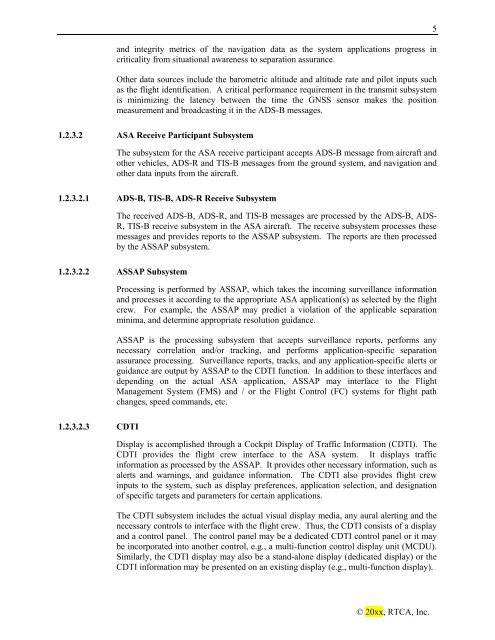Minimum Aviation System Performance Standards for Aircraft ...
Minimum Aviation System Performance Standards for Aircraft ...
Minimum Aviation System Performance Standards for Aircraft ...
Create successful ePaper yourself
Turn your PDF publications into a flip-book with our unique Google optimized e-Paper software.
and integrity metrics of the navigation data as the system applications progress in<br />
criticality from situational awareness to separation assurance.<br />
Other data sources include the barometric altitude and altitude rate and pilot inputs such<br />
as the flight identification. A critical per<strong>for</strong>mance requirement in the transmit subsystem<br />
is minimizing the latency between the time the GNSS sensor makes the position<br />
measurement and broadcasting it in the ADS-B messages.<br />
1.2.3.2 ASA Receive Participant Subsystem<br />
The subsystem <strong>for</strong> the ASA receive participant accepts ADS-B message from aircraft and<br />
other vehicles, ADS-R and TIS-B messages from the ground system, and navigation and<br />
other data inputs from the aircraft.<br />
1.2.3.2.1 ADS-B, TIS-B, ADS-R Receive Subsystem<br />
The received ADS-B, ADS-R, and TIS-B messages are processed by the ADS-B, ADS-<br />
R, TIS-B receive subsystem in the ASA aircraft. The receive subsystem processes these<br />
messages and provides reports to the ASSAP subsystem. The reports are then processed<br />
by the ASSAP subsystem.<br />
1.2.3.2.2 ASSAP Subsystem<br />
1.2.3.2.3 CDTI<br />
Processing is per<strong>for</strong>med by ASSAP, which takes the incoming surveillance in<strong>for</strong>mation<br />
and processes it according to the appropriate ASA application(s) as selected by the flight<br />
crew. For example, the ASSAP may predict a violation of the applicable separation<br />
minima, and determine appropriate resolution guidance.<br />
ASSAP is the processing subsystem that accepts surveillance reports, per<strong>for</strong>ms any<br />
necessary correlation and/or tracking, and per<strong>for</strong>ms application-specific separation<br />
assurance processing. Surveillance reports, tracks, and any application-specific alerts or<br />
guidance are output by ASSAP to the CDTI function. In addition to these interfaces and<br />
depending on the actual ASA application, ASSAP may interface to the Flight<br />
Management <strong>System</strong> (FMS) and / or the Flight Control (FC) systems <strong>for</strong> flight path<br />
changes, speed commands, etc.<br />
Display is accomplished through a Cockpit Display of Traffic In<strong>for</strong>mation (CDTI). The<br />
CDTI provides the flight crew interface to the ASA system. It displays traffic<br />
in<strong>for</strong>mation as processed by the ASSAP. It provides other necessary in<strong>for</strong>mation, such as<br />
alerts and warnings, and guidance in<strong>for</strong>mation. The CDTI also provides flight crew<br />
inputs to the system, such as display preferences, application selection, and designation<br />
of specific targets and parameters <strong>for</strong> certain applications.<br />
The CDTI subsystem includes the actual visual display media, any aural alerting and the<br />
necessary controls to interface with the flight crew. Thus, the CDTI consists of a display<br />
and a control panel. The control panel may be a dedicated CDTI control panel or it may<br />
be incorporated into another control, e.g., a multi-function control display unit (MCDU).<br />
Similarly, the CDTI display may also be a stand-alone display (dedicated display) or the<br />
CDTI in<strong>for</strong>mation may be presented on an existing display (e.g., multi-function display).<br />
© 20xx, RTCA, Inc.<br />
5
















